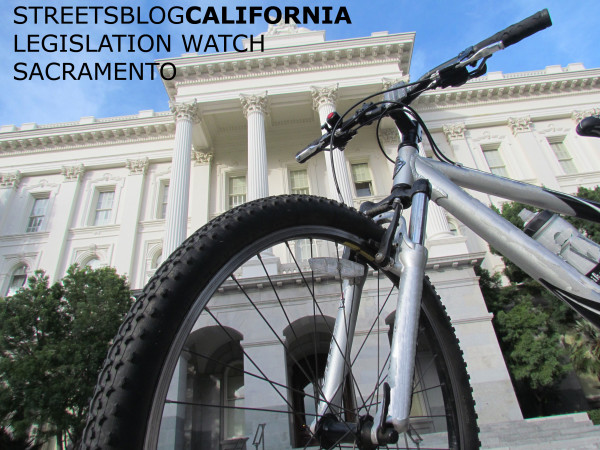This week the California legislature was mostly focused on the budget, since the Assembly and the Senate must by law present a budget bill to the governor by midnight on Monday, June 15. The joint Budget Conference Committee succeeded in producing an agreement [PDF] well before the deadline; their budget bill, A.B. 93, should be available later today, ready to be voted on in both houses on Monday.
To help meet the deadline, the Conference Committee punted decisions on cap-and-trade revenue expenditures by separating them from the budget process. This will give the legislature more time for discussions on how to allocate the 40 percent of cap-and-trade revenue that is not already assigned to programs by last year's statute. Of the three spending plans—from the Governor, the Senate, and the Assembly—only the Assembly plan included an allocation for Active Transportation. The Assembly version called for an additional $50 million for transit pass programs and for infrastructure and programs to increase bicycling and walking.
There is still some disagreement about how much money will actually be available from the cap-and-trade program and how much should be allocated. Governor Brown's May Revise budget proposal outlines expenditures of $2 billion, while the Legislative Analyst Office projects the proceeds to be closer to $2.3 billion. An LAO outline of the different proposals is available [PDF].
Bill to Delay Level of Service (LOS) Reform Amended: A.B. 779, from Assemblymember Cristina Garcia (D-Bell Gardens), was amended last week. The Office of Planning and Research (OPR) was required by last year's S.B. 743 to come up with a way of measuring the effects that new development has on traffic without focusing solely on congestion and delay, as Level of Service currently does. OPR issued a preliminary draft of new guidelines that propose using Vehicle Miles Traveled (VMT) instead of LOS [PDF], but the guidelines are neither final nor legally binding, yet. As first written, A.B. 779 would have broadened the definition of where the LOS reform could happen automatically; then it was amended to delay the substitution of VMT for LOS. Now, however, it simply authorizes OPR to make the determination that residential and mixed-use projects in areas where transit is frequent are exempt from having to analyze traffic impacts.
Like the rest of California's Environmental Quality Act (CEQA), this bill is messy, and its outcomes are uncertain and open to political interpretation. Conservatives generally dislike the CEQA rules, and push to gut its environmental protections. Livability advocates generally appreciate CEQA, but oppose the ways that pro-car pro-sprawl LOS has degraded its intent.
The true intent of the bill's sponsors, the Infill Builders Federation, is not clear. According to the legislative analysis, the group is concerned that having to analyze VMT would create an additional burden that could put infill at a disadvantage—despite the fact that many developers already conduct a VMT analysis, which is simpler than analyzing LOS. The infill group also states that the new guidelines could create an “added litigation burden.”
Under CEQA, if an agency determines that a project will have a less-than-significant impact, it can skip spending time and money on extensive environmental analysis. But CEQA also allows people to sue to force agencies to do a full analysis.
This week's A.B. 779 amendment would authorize—but not require—OPR to define parameters that, if met by a project, would automatically exempt it from having to analyze its traffic impacts. This may shift the burden of proof away from cities and agencies and on to those who claim an impact. Overall that sounds great for infill and for livability, but the devil is in the details. And as currently written, the bill may have the effect of slowing down OPR's process for finding a replacement for LOS—as its previous, now amended, iteration would have regulated outright.
Like any bill, A.B. 779 is still in flux. Currently it is in the Senate, waiting for a committee assignment.
Senate Bill to Raise Gas Tax Is Not Dead Yet: Although S.B. 16 did not get out of the Senate before last week's deadline, an urgency clause attached to it means it is still alive. This bill, from Senator Jim Beall (D-San Jose), would raise money to fix roads in one of the most sensible ways: by raising the gas tax. It would also raise the annual vehicle registration fee, and add a new annual registration fee to zero-emission vehicles, which pay little to no gas tax. This bill will require a two-thirds vote, and it likely will face an uphill battle.
Email tips, alerts, press releases, ideas, etc. to melanie@streetsblog.org.
For social media coverage focused on statewide issues, follow Melanie @currymel on Twitter or like our Facebook page here.






